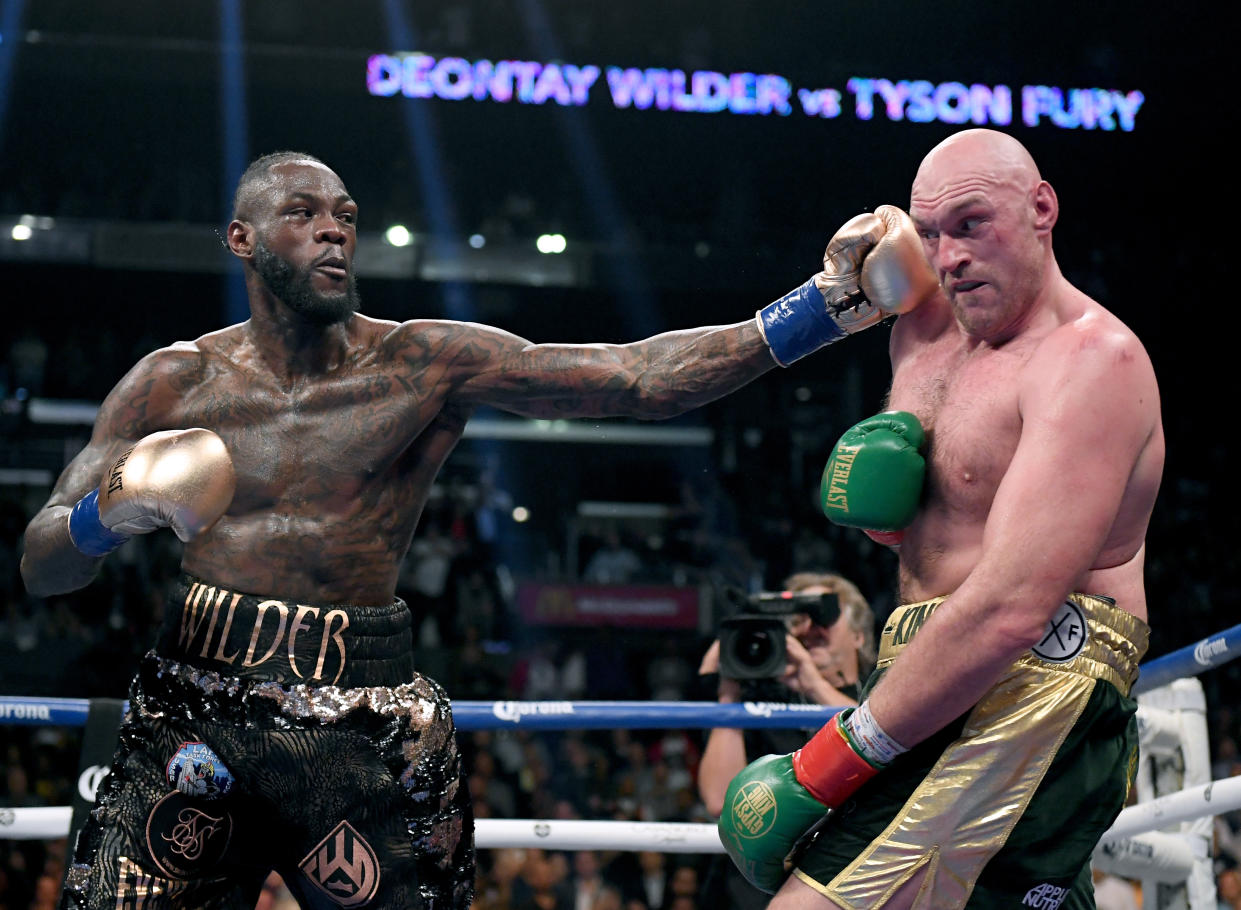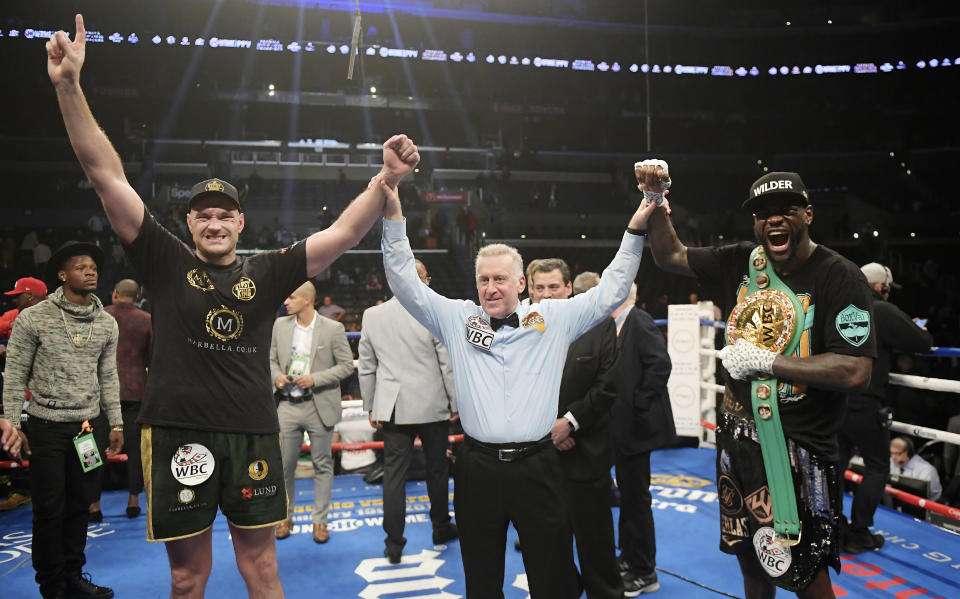Wilder-Fury 2 as good as it gets in heavyweight division since 'The Bite Fight'

The first bout between Muhammad Ali and Joe Frazier on March 8, 1971, was not only the biggest, most significant, top boxing match of the 20th century to that point, it was arguably also the biggest sporting event.
The Ali-Frazier bout transfixed the nation. Both were undefeated men in their primes with an Olympic gold medal in their trophy cases and legitimate claims to being the heavyweight champion.
Ali was stripped of the title in 1967 for refusing induction into the military service when he famously said, “I ain’t got not quarrel with them Vietcong.” Frazier won the vacant belt in the interim and was riding high when Ali returned to action.
The U.S. Supreme Court eventually ruled in 1971 in Ali’s favor on his appeal of his conviction in “Clay versus the United States.”
Frazier won the fight in the ring convincingly and became the man, the way it should be done.
But that fight remains the standard by which all others are judged.
There have been a number of significant heavyweight bouts in the 48 years since, including the third and final meeting between the legends in 1975 in what became known as “The Thrilla in Manila,” that Ali won by TKO when Frazier trainer Eddie Futch wouldn’t let him come out for the 15th round.
The rematch on Feb. 22 at the MGM Grand Garden in Las Vegas between Deontay Wilder and Tyson Fury in no way comes close to either of those fights in terms of significance or importance, but it is the most significant heavyweight bout since the rematch between Mike Tyson and Evander Holyfield in 1997.
Tyson-Holyfield II was the “The Bite Fight,” when an annoyed Tyson twice chomped on Holyfield’s ear during the bout because he was angry that Holyfield had continued to head butt him.
Forgetting the infamous ending, that fight carried significance and importance because of the stature of the two fighters entering it. They were among the biggest names in the sport and were vying for supremacy of the sport’s glamour division.
The rematch between Wilder and Fury is going to be a massive fight that will generate significant revenue, sell a high number of pay-per-views and will have a huge impact on not only the division but the sport as a whole.
In that regard, it’s the sport’s most significant heavyweight fight between since “The Bite Fight,” and there aren’t all that many contenders. The most obvious, of course, was the 2002 match in Memphis, Tennessee, between Tyson and Lennox Lewis, but by that stage, Tyson was a shell of the elite fighter he’d once been.
Lewis’ style is such that he’d probably have beaten Tyson whenever they’d have met, but when they faced off in 2002, Lewis was at his peak and Tyson was badly in decline, so it’s not a fair judge of their relative talents.
Still, Tyson was so huge culturally that the bout became a massively important one, exceeding anything else Lewis did, including his two bouts with Holyfield.
Some may point to the 2003 bout between Lewis and Vitali Klitschko, which was the last of Lewis’ legendary career, as being more significant than Wilder-Fury 2, but it wasn’t at the time. Lewis was supposed to fight Kirk Johnson but he fell out late and Klitschko came in as a last-minute replacement.
The bout didn’t have that much of a build-up and there were still questions about Klitschko at that stage (there shouldn’t have been, but there were).
Since Lewis’ retirement until only recently, the division has been bereft of talent and there have been few major heavyweight bouts. It’s a shame because the decline in talent coincided with Wladimir Klitschko’s development into an elite heavyweight, but he had few legitimate opponents who could help him prove his greatness.

In Wilder and Fury, they’re heading into a rematch off of an entertaining first bout in which the three judges each saw it differently. Judge Robert Tapper had it 114-112 for Fury, giving him eight of the 12 rounds. Judge Alejandro Rochin had it 115-111 for Wilder, giving Wilder seven of the 12. Judge Phil Edwards had it 113-113, giving Fury a 7-5 edge in rounds but scoring it even because of Wilder’s knockdowns in the ninth and 12th rounds.
They also stand 1 and 1A in the heavyweight division, in whichever order one chooses to rank them. The only blemish on either of their records was the draw they had against each other.
The landscape of the division has changed substantially since that Dec. 1, 2018, bout in Los Angeles. Anthony Joshua at the time was the clear and unchallenged choice as the top heavyweight in the world, both in terms of drawing power and talent.
Joshua’s June 1 knockout loss to Andy Ruiz Jr. — which he avenged on Dec. 7 — changed that dramatically.
While there remain those who believe that Joshua is still No. 1 in both categories, their numbers are far fewer than they were before. Fury came to the U.S. to fight in 2019, and while neither of his opponents was considered elite, he gained exposure in the American market that will help him sell the rematch.
He also appeared in a pro wrestling show that gave him additional recognition.
Wilder scored devastating knockouts of Dominic Breazeale and Luis Ortiz and in the process put himself into the conversation as potentially the hardest puncher in the sport’s long history.
The date of the fight is also significant, because it comes two weeks after the Super Bowl, which is always the top television event in the U.S. Given the pay-per-view is a joint production of Fox and ESPN and the Super Bowl is on Fox, the fighters are going to be given unprecedented television access over the next two months.
Name recognition helps drive PPV sales and they’ll be exposed to a huge market beyond the boxing world.
Joe Tessitore, ESPN’s play-by-play man (as well as the voice of the network’s “Monday Night Football” broadcasts), came out and said in a video he believes Wilder-Fury 2 will become the biggest pay-per-view in history.
That currently is the 4.6 million units that were sold for the 2015 bout between Floyd Mayweather and Manny Pacquiao. Few are as optimistic about the success of Wilder-Fury 2 as I am, but Tessitore badly guessed on this. It will be an upset larger than if the Cleveland Browns were to win the next five Super Bowl titles in succession if the fight did better than 4.6 million.
It would be a grand slam home run if it hit 2 million.
There were six boxing pay-per-view shows in 2019 which didn’t do much more than 2 million sales combined, and that’s giving the networks that sold them the benefit of the doubt with the sales figures.
There is no way that Wilder and Fury will sell more than 4 million pay-per-views in the U.S. in February. It’s just not happening.
But it’s still a mega-event that will not only sell in large numbers, and attract a premium gate, but which will have an unduly large impact upon the future of the sport.
A healthy heavyweight division is always good for boxing and having two unbeaten men with a claim to the title — Wilder holds the WBC belt and Fury is the lineal champion — fighting each other is only going to help.
The fact that you have to go back more than two decades to find a fight that exceeds it tells you how big this bout will be.
It’s not going to be 4.6 million-sales big, but this is a fight that will both do business and have an impact. In modern boxing, that’s about as good as it gets.
More from Yahoo Sports:


